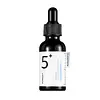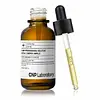What's inside
What's inside
 Key Ingredients
Key Ingredients

 Benefits
Benefits

 Concerns
Concerns

 Ingredients Side-by-side
Ingredients Side-by-side

Vaccinium Vitis-Idaea Fruit Extract
AntioxidantButylene Glycol
HumectantNiacinamide
SmoothingPanthenol
Skin ConditioningTranexamic Acid
AstringentWater
Skin Conditioning1,2-Hexanediol
Skin ConditioningNeopentyl Glycol Dicaprate
EmollientCaprylic/Capric Triglyceride
MaskingSorbitol
HumectantBifida Ferment Lysate
Skin ConditioningChondrus Crispus Extract
Skin ConditioningButyrospermum Parkii Butter
Skin ConditioningSaccharum Officinarum Extract
MoisturisingAlpha-Arbutin
AntioxidantSodium Hyaluronate
HumectantMelia Azadirachta Flower Extract
Skin ConditioningOcimum Sanctum Leaf Extract
Skin ConditioningMelia Azadirachta Leaf Extract
Skin ConditioningCurcuma Longa Root Extract
MaskingCorallina Officinalis Extract
Skin ConditioningTremella Fuciformis Extract
HumectantPentylene Glycol
Skin ConditioningGlycerin
Humectant3-O-Ethyl Ascorbic Acid
Skin ConditioningBisabolol
MaskingTromethamine
BufferingEthylhexylglycerin
Skin ConditioningAdenosine
Skin ConditioningHydrogenated Lecithin
EmulsifyingAllantoin
Skin ConditioningGlutathione
Ceramide NP
Skin ConditioningBeta-Glucan
Skin ConditioningDipotassium Glycyrrhizate
HumectantTocopherol
AntioxidantAscorbic Acid
AntioxidantAscorbyl Glucoside
AntioxidantTocopheryl Acetate
AntioxidantHydroxypropyl Cyclodextrin
MaskingUbiquinone
AntioxidantThioctic Acid
AntioxidantPotassium Hydroxide
BufferingBehenyl Alcohol
EmollientCarbomer
Emulsion StabilisingXanthan Gum
EmulsifyingDisodium EDTA
Vaccinium Vitis-Idaea Fruit Extract, Butylene Glycol, Niacinamide, Panthenol, Tranexamic Acid, Water, 1,2-Hexanediol, Neopentyl Glycol Dicaprate, Caprylic/Capric Triglyceride, Sorbitol, Bifida Ferment Lysate, Chondrus Crispus Extract, Butyrospermum Parkii Butter, Saccharum Officinarum Extract, Alpha-Arbutin, Sodium Hyaluronate, Melia Azadirachta Flower Extract, Ocimum Sanctum Leaf Extract, Melia Azadirachta Leaf Extract, Curcuma Longa Root Extract, Corallina Officinalis Extract, Tremella Fuciformis Extract, Pentylene Glycol, Glycerin, 3-O-Ethyl Ascorbic Acid, Bisabolol, Tromethamine, Ethylhexylglycerin, Adenosine, Hydrogenated Lecithin, Allantoin, Glutathione, Ceramide NP, Beta-Glucan, Dipotassium Glycyrrhizate, Tocopherol, Ascorbic Acid, Ascorbyl Glucoside, Tocopheryl Acetate, Hydroxypropyl Cyclodextrin, Ubiquinone, Thioctic Acid, Potassium Hydroxide, Behenyl Alcohol, Carbomer, Xanthan Gum, Disodium EDTA
Water
Skin ConditioningButylene Glycol
HumectantGlycerin
HumectantSodium Ascorbyl Phosphate
AntioxidantNiacinamide
SmoothingAscorbyl Glucoside
Antioxidant1,2-Hexanediol
Skin ConditioningPanthenol
Skin ConditioningImperata Cylindrica Root Extract
Skin ConditioningPolysorbate 60
EmulsifyingXanthan Gum
EmulsifyingPentylene Glycol
Skin ConditioningAllantoin
Skin ConditioningSophora Angustifolia Root Extract
Skin ConditioningSodium Hyaluronate
HumectantTrisodium EDTA
Hydroxyphenyl Propamidobenzoic Acid
Skin ConditioningBeta-Glucan
Skin ConditioningPelargonium Graveolens Flower Oil
MaskingCoptis Japonica Root Extract
Skin ConditioningCaprylyl Glycol
EmollientCarbomer
Emulsion StabilisingSodium Citrate
BufferingCitric Acid
BufferingHouttuynia Cordata Extract
Skin ConditioningFructose
HumectantUrea
BufferingSodium Hydroxide
BufferingGinkgo Biloba Nut Extract
Skin ConditioningCodonopsis Lanceolata Root Extract
Skin ConditioningFicus Carica Fruit Extract
HumectantMaltose
MaskingMelissa Officinalis Leaf Extract
Skin ConditioningPunica Granatum Fruit Extract
AntioxidantSodium Chloride
MaskingSodium Lactate
BufferingSodium PCA
HumectantTrehalose
HumectantAcrylates/C10-30 Alkyl Acrylate Crosspolymer
Emulsion StabilisingAscorbyl Palmitate
AntioxidantMadecassoside
AntioxidantGlucose
HumectantBiotin
AntiseborrhoeicLecithin
EmollientPolysorbate 20
EmulsifyingGlutathione
Disodium EDTA
Citronellol
PerfumingGeraniol
PerfumingWater, Butylene Glycol, Glycerin, Sodium Ascorbyl Phosphate, Niacinamide, Ascorbyl Glucoside, 1,2-Hexanediol, Panthenol, Imperata Cylindrica Root Extract, Polysorbate 60, Xanthan Gum, Pentylene Glycol, Allantoin, Sophora Angustifolia Root Extract, Sodium Hyaluronate, Trisodium EDTA, Hydroxyphenyl Propamidobenzoic Acid, Beta-Glucan, Pelargonium Graveolens Flower Oil, Coptis Japonica Root Extract, Caprylyl Glycol, Carbomer, Sodium Citrate, Citric Acid, Houttuynia Cordata Extract, Fructose, Urea, Sodium Hydroxide, Ginkgo Biloba Nut Extract, Codonopsis Lanceolata Root Extract, Ficus Carica Fruit Extract, Maltose, Melissa Officinalis Leaf Extract, Punica Granatum Fruit Extract, Sodium Chloride, Sodium Lactate, Sodium PCA, Trehalose, Acrylates/C10-30 Alkyl Acrylate Crosspolymer, Ascorbyl Palmitate, Madecassoside, Glucose, Biotin, Lecithin, Polysorbate 20, Glutathione, Disodium EDTA, Citronellol, Geraniol
 Reviews
Reviews

Ingredients Explained
These ingredients are found in both products.
Ingredients higher up in an ingredient list are typically present in a larger amount.
1,2-Hexanediol is a synthetic liquid and another multi-functional powerhouse.
It is a:
- Humectant, drawing moisture into the skin
- Emollient, helping to soften skin
- Solvent, dispersing and stabilizing formulas
- Preservative booster, enhancing the antimicrobial activity of other preservatives
Allantoin is a soothing ingredient known for its protective and moisturizingg properties. Because of this, it is often added to products with strong active ingredients.
Studies show higher concentrations of this ingredient can promote wound healing.
Though it can be derived from the comfrey plant, allantoin is produced synthetically for cosmetic products to ensure purity.
Learn more about AllantoinAscorbyl Glucoside is a stable form of Vitamin C. It is created by combining glucose from starch.
When applied to skin, Ascorbyl Glucoside turns into Ascorbic Acid.
Ascorbyl Glucoside is an antioxidant. Antioxidants help fight free-radicals, or molecules that may damage skin cells.
It can help to reduce redness, improve skin texture, reduce the effects of aging, reduce the visibility of dark spots, and brighten skin.
Read more about other types of Vitamin C:
Learn more about Ascorbyl GlucosideBeta-Glucan is a polysaccharide. It can be derived from the cell walls of seaweed, oats, yeast, and fungi. It hydrates the skin and helps boost your skin's natural barrier.
As an antioxidant, beta-glucan helps fight free-radicals. Free-radicals are molecules that may damage your skin cells, such as pollution.
Studies show this ingredient may be an effective wrinkle reducer as it can deeply penetrate into skin. It has also been show to help with wound healing.
Learn more about Beta-GlucanButylene Glycol (or BG) is used within cosmetic products for a few different reasons:
Overall, Butylene Glycol is a safe and well-rounded ingredient that works well with other ingredients.
Though this ingredient works well with most skin types, some people with sensitive skin may experience a reaction such as allergic rashes, closed comedones, or itchiness.
Learn more about Butylene GlycolCarbomer is a polymer of acrylic acid. Its main role is to create a gel consistency.
A high amount of carbomer can cause pilling or balling up of products. Don't worry, most products contain 1% or less of carbomer.
Disodium EDTA plays a role in making products more stable by aiding other preservatives.
It is a chelating agent, meaning it neutralizes metal ions that may be found in a product.
Disodium EDTA is a salt of edetic acid and is found to be safe in cosmetic ingredients.
Learn more about Disodium EDTAGlutathione is an antioxidant naturally found in our bodies. It is made up of three amino acids: glycine, cysteine, and glutamic acid.
As an antioxidant, it prevents oxidative damage to parts of our cell.
While glutathione is said to help with fading dark spots, the results from research are inconclusive. Further studies are needed. With that said, gluthatione has been shown to protect our skin from UV-B induced damage.
This ingredient is naturally occurring in plants, animals, fungi, and some bacteria.
Learn more about GlutathioneGlycerin is already naturally found in your skin. It helps moisturize and protect your skin.
A study from 2016 found glycerin to be more effective as a humectant than AHAs and hyaluronic acid.
As a humectant, it helps the skin stay hydrated by pulling moisture to your skin. The low molecular weight of glycerin allows it to pull moisture into the deeper layers of your skin.
Hydrated skin improves your skin barrier; Your skin barrier helps protect against irritants and bacteria.
Glycerin has also been found to have antimicrobial and antiviral properties. Due to these properties, glycerin is often used in wound and burn treatments.
In cosmetics, glycerin is usually derived from plants such as soybean or palm. However, it can also be sourced from animals, such as tallow or animal fat.
This ingredient is organic, colorless, odorless, and non-toxic.
Glycerin is the name for this ingredient in American English. British English uses Glycerol/Glycerine.
Learn more about GlycerinNiacinamide is a multitasking form of vitamin B3 that strengthens the skin barrier, reduces pores and dark spots, regulates oil, and improves signs of aging.
And the best part? It's gentle and well-tolerated by most skin types, including sensitive and reactive skin.
You might have heard of "niacin flush", or the reddening of skin that causes itchiness. Niacinamide has not been found to cause this.
In very rare cases, some individuals may not be able to tolerate niacinamide at all or experience an allergic reaction to it.
If you are experiencing flaking, irritation, and dryness with this ingredient, be sure to double check all your products as this ingredient can be found in all categories of skincare.
When incorporating niacinamide into your routine, look out for concentration amounts. Typically, 5% niacinamide provides benefits such as fading dark spots. However, if you have sensitive skin, it is better to begin with a smaller concentration.
When you apply niacinamide to your skin, your body converts it into nicotinamide adenine dinucleotide (NAD). NAD is an essential coenzyme that is already found in your cells as "fuel" and powers countless biological processes.
In your skin, NAD helps repair cell damage, produce new healthy cells, support collagen production, strengthen the skin barrier, and fight environmental stressors (like UV and pollution).
Our natural NAD levels start to decline with age, leading to slower skin repair, visible aging, and a weaker skin barrier. By providing your skin niacinamide, you're recharging your skin's NAD levels. This leads to stronger, healthier, and younger looking skin.
Another name for vitamin B3 is nicotinamide. This vitamin is water-soluble and our bodies don't store it. We obtain Vitamin B3 from either food or skincare. Meat, fish, wheat, yeast, and leafy greens contain vitamin B3.
The type of niacinamide used in skincare is synthetically created.
Learn more about NiacinamidePanthenol is a common ingredient that helps hydrate and soothe the skin. It is found naturally in our skin and hair.
There are two forms of panthenol: D and L.
D-panthenol is also known as dexpanthenol. Most cosmetics use dexpanthenol or a mixture of D and L-panthenol.
Panthenol is famous due to its ability to go deeper into the skin's layers. Using this ingredient has numerous pros (and no cons):
Like hyaluronic acid, panthenol is a humectant. Humectants are able to bind and hold large amounts of water to keep skin hydrated.
This ingredient works well for wound healing. It works by increasing tissue in the wound and helps close open wounds.
Once oxidized, panthenol converts to pantothenic acid. Panthothenic acid is found in all living cells.
This ingredient is also referred to as pro-vitamin B5.
Learn more about PanthenolPentylene glycol is typically used within a product to thicken it. It also adds a smooth, soft, and moisturizing feel to the product. It is naturally found in plants such as sugar beets.
The hydrophilic trait of Pentylene Glycol makes it a humectant. As a humectant, Pentylene Glycol helps draw moisture from the air to your skin. This can help keep your skin hydrated.
This property also makes Pentylene Glycol a great texture enhancer. It can also help thicken or stabilize a product.
Pentylene Glycol also acts as a mild preservative and helps to keep a product microbe-free.
Some people may experience mild eye and skin irritation from Pentylene Glycol. We always recommend speaking with a professional about using this ingredient in your routine.
Pentylene Glycol has a low molecular weight and is part of the 1,2-glycol family.
Learn more about Pentylene GlycolSodium Hyaluronate is hyaluronic acid's salt form. It is commonly derived from the sodium salt of hyaluronic acid.
Like hyaluronic acid, it is great at holding water and acts as a humectant. This makes it a great skin hydrating ingredient.
Sodium Hyaluronate is naturally occurring in our bodies and is mostly found in eye fluid and joints.
These are some other common types of Hyaluronic Acid:
Learn more about Sodium HyaluronateWater. It's the most common cosmetic ingredient of all. You'll usually see it at the top of ingredient lists, meaning that it makes up the largest part of the product.
So why is it so popular? Water most often acts as a solvent - this means that it helps dissolve other ingredients into the formulation.
You'll also recognize water as that liquid we all need to stay alive. If you see this, drink a glass of water. Stay hydrated!
Learn more about WaterXanthan gum is used as a stabilizer and thickener within cosmetic products. It helps give products a sticky, thick feeling - preventing them from being too runny.
On the technical side of things, xanthan gum is a polysaccharide - a combination consisting of multiple sugar molecules bonded together.
Xanthan gum is a pretty common and great ingredient. It is a natural, non-toxic, non-irritating ingredient that is also commonly used in food products.
Learn more about Xanthan Gum